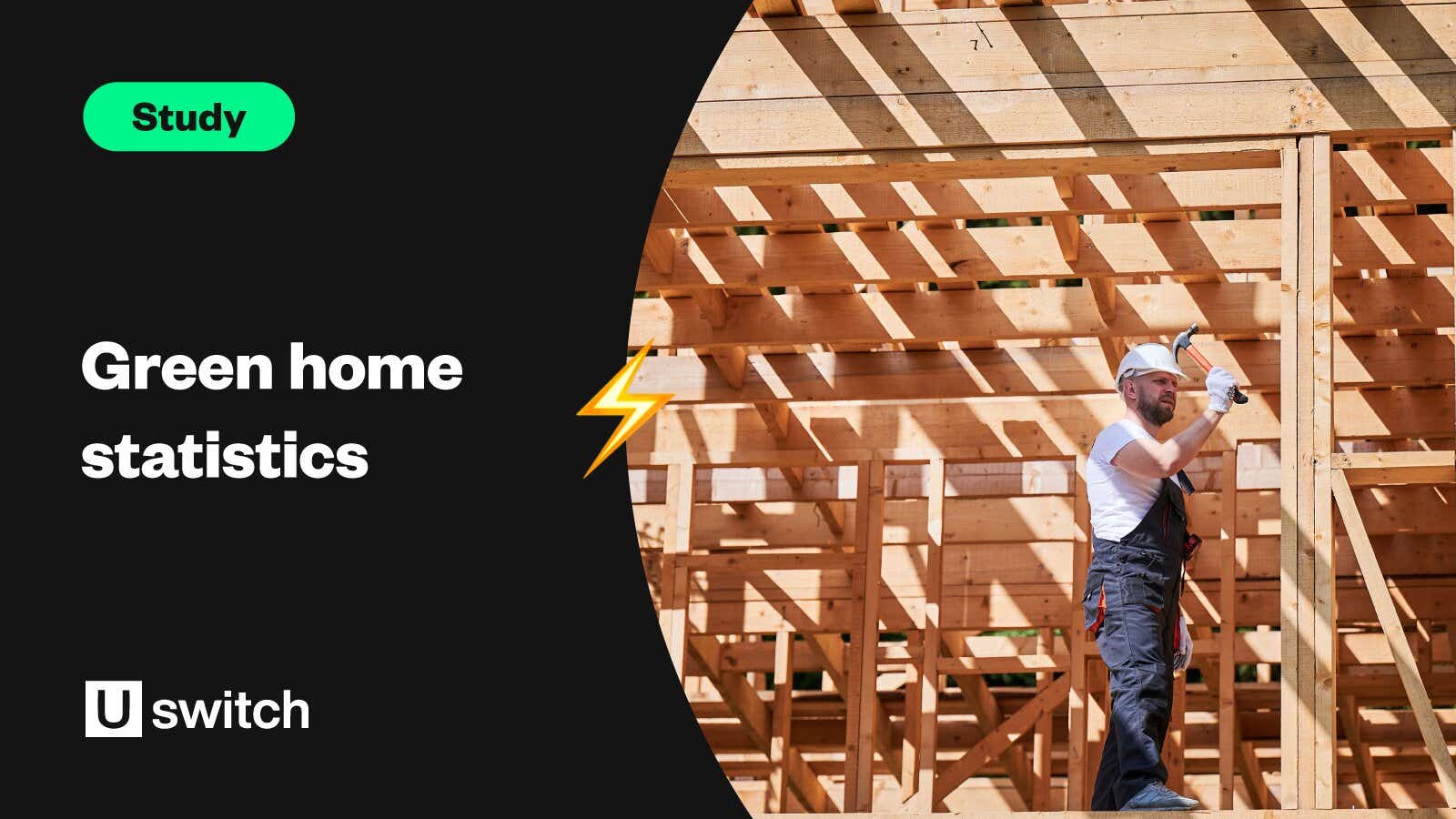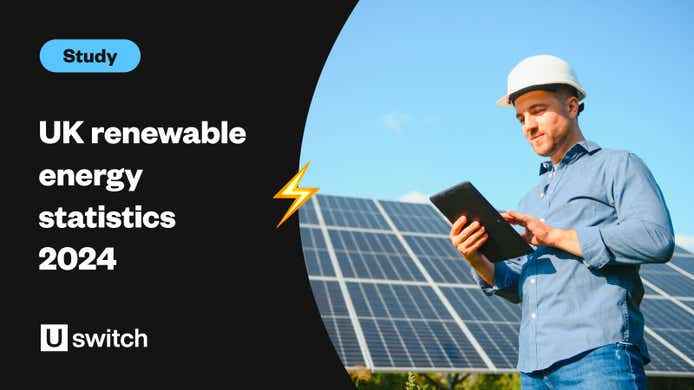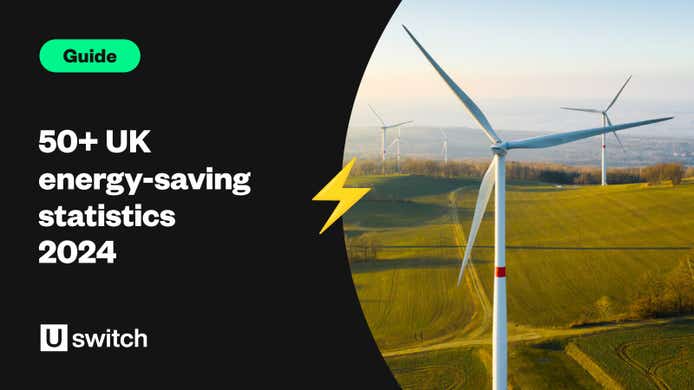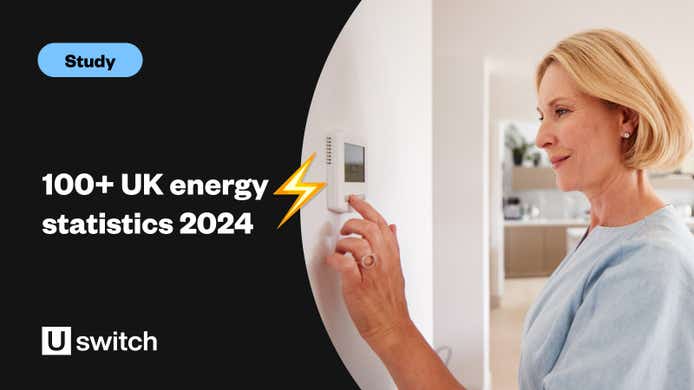As green energy becomes an increasingly prominent part of modern life, interest in eco-friendly home renovations continues to grow. From government legislation relating to home energy efficiency to public demand for renewable power sources, the move towards greener homes will play a key part in the UK's ability to meet its net zero target by 2050.
That’s why we’ve compiled 10 of the most important green home statistics driving the industry today. These stats offer insight into the state of the green homes market in 2024, people’s attitudes to having renewable energy at home, and the most popular sources of domestic green energy.
1. How many solar panels are there in UK homes?
There were nearly 1.5 million solar panels used on UK homes in April 2024 – a 13% rise from the same time in 2023. The number of solar panels rose steadily year-on-year since 2018, when there were just over 934,000 homes using them.
The number of domestic solar panels on UK homes, April 2018-2024

| Month/year | Total number of domestic solar panels in the UK |
|---|---|
| April 2018 | 934,486 |
| April 2019 | 990,214 |
| April 2020 | 1,024,942 |
| April 2021 | 1,067,693 |
| April 2022 | 1,145,498 |
| April 2023 | 1,320,783 |
| April 2024 | 1,498,949 |
(Source: Department for Energy Security and Net Zero)
The number of solar panels in homes would rise 6% in April 2019 before surpassing a million for the first time in 2020 (+8%). Between 2020 and 2023, the number of home solar panels increased nearly a quarter (23%) to just over 1.3 million, before rising a further 13% a year later.
The latest figure for 2024 means the total number of home solar panels in the UK climbed by 40% from April 2018 to 2024.
2. How many heat pumps are there in UK homes?
The total number of heat pumps installed in UK homes accelerated between 2022 and 2023, rising by nearly a fifth (19%) from 32,910 to 39,268. This meant that the overall number of heat pumps in UK homes surpassed 200,000 for the first time.
Air source heat pumps saw the biggest increase in uptake, rising 25% to just under 37,000, while ground-source heat pump installations fell by more than a quarter (-27%).
The number of heat pumps installed in UK homes by year and type

| Green energy source | Number of installations in UK homes in 2022 | Number of installations in UK homes in 2023 |
|---|---|---|
| Air source heat pump | 29,490 | 36,799 |
| Ground source heat pump | 3,420 | 2,469 |
| Total heat pumps | 32,910 | 39,268 |
(Source: MCS Foundation)
The MCS said that the increased uptake in heat pumps was being driven by the demand for carbon-free heating, supported by government grants like the Boiler Upgrade Scheme. The scheme’s maximum grant was increased from £5,000 to £7,500 in October 2023, sparking a 50% increase in applications.
3. How do people feel about green homes?
A 2023 survey from Censuswide found that over half (57%) of UK consumers were willing to pay more for a house with renewable or low-carbon energy sources like solar panels, heat pumps or EV chargers.
The same survey found a quarter (25%) saying they’d be willing to spend between £15k and £25k extra for a green property, with more than one in 10 (11%) willing to pay more than £45k extra.
Only a quarter (25%) of those surveyed claimed they wouldn’t be willing to pay any extra for a house with green technology.
4. What can be done to encourage people to make their homes greener?
Green home stats from Censuswide found that more than half (55%) of UK survey respondents believe their mortgage should be lower if their home is greener. A similar amount (53%) thought their council tax should be lower if they made green adjustments.
These figures rose even higher in the capital, with nearly two-thirds of Greater London residents believing they should have cheaper mortgage rates (64%) or council tax (63%) for adopting greener home measures.
The same report found that more than a quarter (28%) of respondents had already upgraded the insulation in their homes, and a further 24% were considering doing so in the future.
5. Are UK homes becoming more energy-efficient?
Analysis of green home stats found that more than a third (36%) of UK houses for sale in 2023 had an Energy Performance Certificate rating of A-C – up 6% from 2019 (30%). EPC ratings are a marker of how energy efficient a building is, with "A" being considered very efficient and "G" very inefficient.
The percentage of UK houses for sale by EPC rating (2019-2023)
| Year | Percentage of houses for sale in Great Britain with an EPC rating of D-G | Percentage of houses for sale in Great Britain with an EPC rating of A-C | Percentage of flats for sale in Great Britain with an EPC rating of D-G | Percentage of flats for sale in Great Britain with an EPC rating of A-C |
|---|---|---|---|---|
| 2019 | 70 | 30 | 43 | 57 |
| 2023 | 64 | 36 | 37 | 63 |
(Source: Rightmove)
Nearly two-thirds (64%) of houses for sale had an EPC rating of D-G in 2023–down 6% from 2019 (70%).
At the same time, the number of flats for sale with an A-C EPC rating increased by 6% from over half (57%) in 2019 to nearly two-thirds (63%) in 2023.
6. How much CO2 does the average UK home produce?
Green home statistics show that the average CO2 emissions in a UK house up for sale in 2023 was 4.99 tonnes. This represents an 8% reduction from 2019, when the average for-sale house emitted 5.45 tonnes of CO2.
The average CO2 emission of a flat for sale in 2023 was 2.53 tonnes – down 9% from 2019 (2.77 tonnes).
The average CO2 emissions produced by UK houses and flats on the market in 2019 and 2023

At the same time, houses up for rent experienced far lower reductions. The typical house up for rent in 2023 emitted 4.57 tonnes of CO2 – just 1% lower than the average house in 2019 (4.52 tonnes).
However, flats for rent experienced much bigger drops, falling from 2.82 tonnes in 2019 to 2.57 in 2023. This represents a decline of around 9% over four years.
7. Which region has the most eco-friendly homes?
London has the most homes with an EPC rating between A and C of any region in Great Britain. Nearly half (48%) of the English capital’s homes were rated at this level – an 11% rise from 2019. This also made London the most improved region for EPC ratings between 2019 and 2023.
The percentage of homes in Great Britain with an EPC rating between A and C by year and region

At the other end of the scale, Wales had the lowest percentage of homes with an EPC rating of A-C, at just less than a third (32%). While this was 5% lower than any other region, it marked a 7% rise from 2019, when just a quarter of homes (25%) were rated A-C.
This was the joint-second highest rise over four years, with the West Midlands and Yorkshire and the Humber also experiencing 7% increases to 38% and 37%, respectively.
8. Does making your home greener increase its value?
Improving a property's EPC rating from "D" to "C" can increase its value by more than £11,000 on average. When looking at the value of the typical UK home, this would represent a rise of 3%.
The average property value increases from improving EPC ratings by various levels

Improving an EPC from "E" to "C" typically increases a property's value by just over £26,000. This is more than double (+133%) the value gained from increasing an EPC from "D" to "C", representing a 7% value rise on the average home.
Improving an EPC rating from "F" to "C" is likely to increase property value by nearly £56,000 or 15%. This is around five times more than the value gained from improving an EPC from "D" to "C".
9. What are the most popular green home improvements?
A 2023 survey from Rightmove found that nearly three-quarters of respondents (72%) had switched to energy-efficient lighting. This was the most commonly referenced green home improvement and 15% more than any other answer.
The percentage of survey respondents who’ve made various eco-home renovations
| Eco-home renovation | Percentage of surveyed homeowners who’ve made this renovation to their property |
|---|---|
| Switch to energy-efficient lighting | 72% |
| Install double or triple-glazing | 57% |
| Upgrade central heating controls | 55% |
| Upgrade boiler | 49% |
| Add or improve loft installation | 49% |
| Add floor insulation | 17% |
| Install solar panels | 8% |
| Install a heat pump | 3% |
(Source: Rightmove)
Installing double or triple glazing (57%) and upgrading heating controls (55%) were the only other renovations referenced by more than half of respondents, with just under half claiming they’d upgraded their boiler (49%).
At the other end of the scale, less than one in 10 (8%) said they’d installed solar panels, and less than one in twenty (3%) said they'd installed a heat pump.
10. Which UK nation has the highest percentage of green homes?
A report from the MCS Foundation certified found that Wales had the highest percentage of green homes among the four UK nations. Nearly one in 10 (8.74%) Welsh homes now contain a renewable energy installation like solar PV, battery storage, or a heat pump.
The percentage of UK homes with renewable energy installations by country

Scotland had the next highest percentage of green homes, with a total of 8.47%–less than 0.3% fewer than Wales.
Just over one in twenty (5.86%) English homes had renewable energy installations, which was more than 2.5% less than Scotland. Northern Ireland’s total of 4.41% was just over half the total for Wales and the lowest of the UK nations overall.
FAQs
Can renewable energy be used for heating?
Yes. There are numerous forms of entirely renewable heating options you can have installed to generate energy in your home. The three main examples of renewable heating are:
- Solar panels
- Heat pumps
- Biomass boilers
To find out more about these energy sources and other renewable options, check out our low-carbon heating guide.
Why is renewable energy so important for the future?
Renewable energy produces zero carbon emissions when used. With the world in the midst of an ongoing environmental crisis, widespread use of renewable energy will help combat the effects of climate change, reduce air pollution, and improve the health of the planet.
Is renewable energy reliable?
Yes. Renewable energy is reliable as there are no limits to the amount of solar, wind, or geothermal power the earth provides. Unlike finite resources like fossil fuels and nuclear power, renewable resources will never run out and will, therefore, be more reliable sources of energy over time.
Methodology and sources
https://www.greenbuildingrenewables.co.uk/green-homes-and-extreme-weather/
https://www.gov.uk/government/statistics/solar-photovoltaics-deployment
https://www.rightmove.co.uk/guides/content/uploads/2023/07/Rightmove_Greener_Homes_Report_2023.pdf
https://mcsfoundation.org.uk/news/record-number-of-heat-pumps-installed-in-uk-homes-in-2023/





